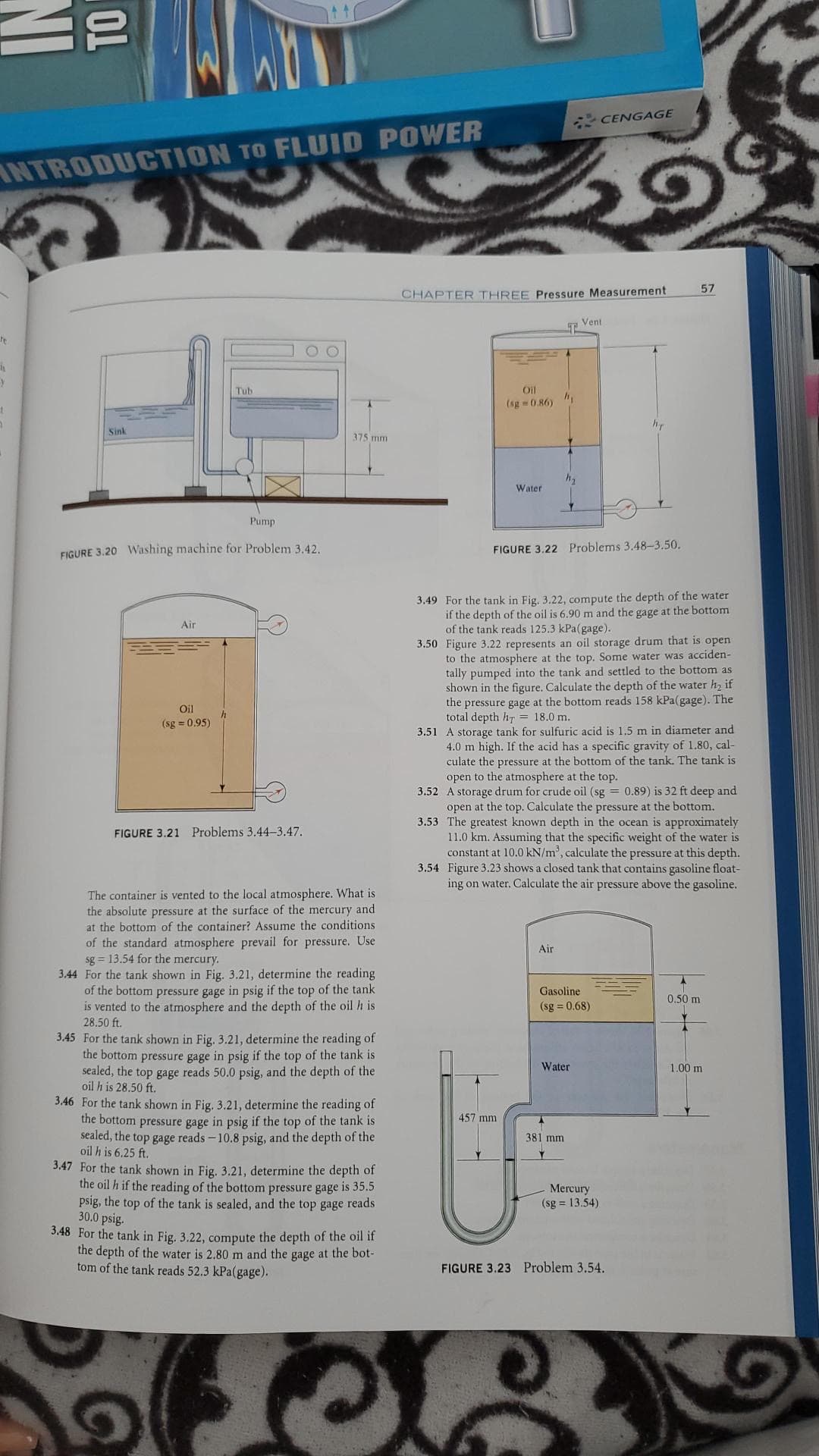3.48 For the tank in Fig. 3.22, compute the depth of the oil if the depth of the water is 2.80 m and the gage at the bot- tom of the tank reads 52.3 kPa(gage).
3.48 For the tank in Fig. 3.22, compute the depth of the oil if the depth of the water is 2.80 m and the gage at the bot- tom of the tank reads 52.3 kPa(gage).
Elements Of Electromagnetics
7th Edition
ISBN:9780190698614
Author:Sadiku, Matthew N. O.
Publisher:Sadiku, Matthew N. O.
ChapterMA: Math Assessment
Section: Chapter Questions
Problem 1.1MA
Related questions
Question
can you please find the solution for the que no: 3.48

Transcribed Image Text:TO
CENGAGE
INTRODUCTION TO FLUID POWER
57
CHAPTER THREE Pressure Measurement
Vent
Tub
Oil
(sg 0.86)
Sink
375 mm
Water
Pump
FIGURE 3.20 Washing machine for Problem 3.42.
FIGURE 3.22 Problems 3.48-3.50.
3.49 For the tank in Fig. 3.22, compute the depth of the water
if the depth of the oil is 6.90 m and the gage at the bottom
of the tank reads 125.3 kPa(gage).
3.50 Figure 3.22 represents an oil storage drum that is open
to the atmosphere at the top. Some water was acciden-
tally pumped into the tank and settled to the bottom as
shown in the figure. Calculate the depth of the water h, if
the pressure gage at the bottom reads 158 kPa(gage). The
total depth hr = 18.0 m.
3.51 A storage tank for sulfuric acid is 1.5 m in diameter and
4.0 m high. If the acid has a specific gravity of 1.80, cal-
culate the pressure at the bottom of the tank. The tank is
open to the atmosphere at the top.
3.52 A storage drum for crude oil (sg = 0.89) is 32 ft deep and
open at the top. Calculate the pressure at the bottom.
3.53 The greatest known depth in the ocean is approximately
11.0 km. Assuming that the specific weight of the water is
constant at 10.0 kN/m', calculate the pressure at this depth.
3.54 Figure 3.23 shows a closed tank that contains gasoline float-
ing on water. Calculate the air pressure above the gasoline.
Air
Oil
(sg = 0.95)
FIGURE 3.21 Problems 3.44-3.47.
The container is vented to the local atmosphere. What is
the absolute pressure at the surface of the mercury and
at the bottom of the container? Assume the conditions
of the standard atmosphere prevail for pressure. Use
sg = 13.54 for the mercury.
3.44 For the tank shown in
Air
3.21, determine the reading
of the bottom pressure gage in psig if the top of the tank
is vented to the atmosphere and the depth of the oil h is
28.50 ft.
Gasoline
0.50 m
(sg = 0.68)
3.45 For the tank shown in Fig. 3.21, determine the reading of
the bottom pressure gage in psig if the top of the tank is
sealed, the top gage reads 50.0 psig, and the depth of the
oil h is 28.50 ft.
3.46 For the tank shown in Fig. 3.21, determine the reading of
the bottom pressure gage in psig if the top of the tank is
sealed, the top gage reads -10.8 psig, and the depth of the
oil h is 6.25 ft.
Water
1.00 m
457mm
381 mm
3.47 For the tank shown in Fig. 3.21, determine the depth of
the oil h if the reading of the bottom pressure gage is 35.5
psig, the top of the tank is sealed, and the top gage reads
30.0 psig.
3.48 For the tank in Fig. 3.22, compute the depth of the oil if
the depth of the water is 2.80 m and the gage at the bot-
tom of the tank reads 52.3 kPa(gage).
Mercury
(sg = 13.54)
FIGURE 3.23 Problem 3.54.
Expert Solution
This question has been solved!
Explore an expertly crafted, step-by-step solution for a thorough understanding of key concepts.
This is a popular solution!
Trending now
This is a popular solution!
Step by step
Solved in 2 steps with 2 images

Knowledge Booster
Learn more about
Need a deep-dive on the concept behind this application? Look no further. Learn more about this topic, mechanical-engineering and related others by exploring similar questions and additional content below.Recommended textbooks for you

Elements Of Electromagnetics
Mechanical Engineering
ISBN:
9780190698614
Author:
Sadiku, Matthew N. O.
Publisher:
Oxford University Press

Mechanics of Materials (10th Edition)
Mechanical Engineering
ISBN:
9780134319650
Author:
Russell C. Hibbeler
Publisher:
PEARSON

Thermodynamics: An Engineering Approach
Mechanical Engineering
ISBN:
9781259822674
Author:
Yunus A. Cengel Dr., Michael A. Boles
Publisher:
McGraw-Hill Education

Elements Of Electromagnetics
Mechanical Engineering
ISBN:
9780190698614
Author:
Sadiku, Matthew N. O.
Publisher:
Oxford University Press

Mechanics of Materials (10th Edition)
Mechanical Engineering
ISBN:
9780134319650
Author:
Russell C. Hibbeler
Publisher:
PEARSON

Thermodynamics: An Engineering Approach
Mechanical Engineering
ISBN:
9781259822674
Author:
Yunus A. Cengel Dr., Michael A. Boles
Publisher:
McGraw-Hill Education

Control Systems Engineering
Mechanical Engineering
ISBN:
9781118170519
Author:
Norman S. Nise
Publisher:
WILEY

Mechanics of Materials (MindTap Course List)
Mechanical Engineering
ISBN:
9781337093347
Author:
Barry J. Goodno, James M. Gere
Publisher:
Cengage Learning

Engineering Mechanics: Statics
Mechanical Engineering
ISBN:
9781118807330
Author:
James L. Meriam, L. G. Kraige, J. N. Bolton
Publisher:
WILEY